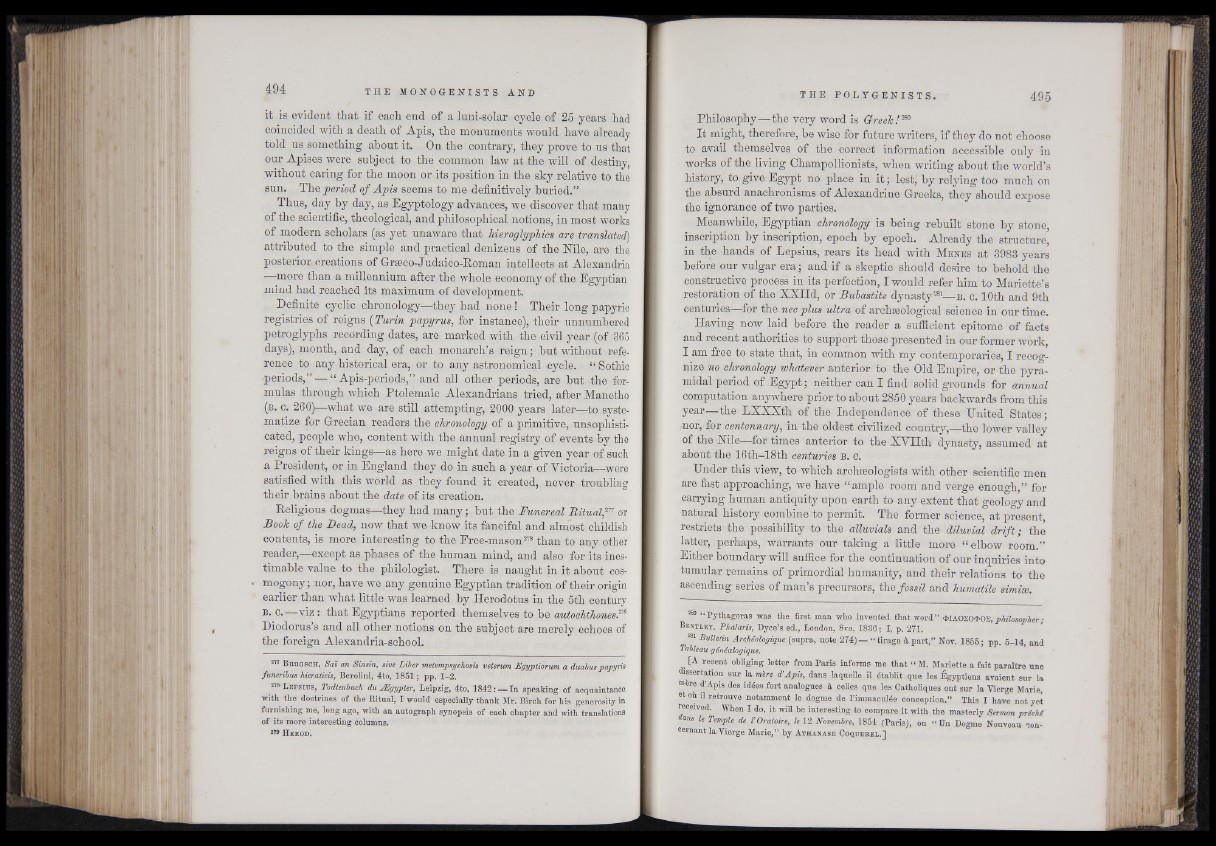
it is evident that if each end of a luni-solar cycle of 25 years had
coincided with a death of Apis, the monuments would have already
told us something about it. On the contrary, they prove to us that
our Apises were subject to the common law at the will of destiny,
without caring for the moon or its position in the sky relative to the
sun. The period of Apis seems to me definitively buried.”
Thus, day by day, as Egyptology advances, we discover that many
of the scientific, theological, and philosophical notions, in most works
of modern scholars (as yet unaware that hieroglyphics are translated)
attributed to the simple and practical denizens of the Nile, are the
posterior creations of Graeco-Judaico-Eoman intellects at Alexandria
—more than, a millennium after the whole economy of the Egyptian
mind had reached its maximum of development.
Definite cyclic chronology—they had none ! Their long papyric
registries of reigns (Turin papyrus, for instance), their unnumbered
petroglyphs recording dates, are marked with the civil year (of 365
days), month, and day, of each monarch’s reign; but without reference
to any historical era, or to any astronomical cycle. “ Sothic
periods,” — “ Apis-periods,” and all other periods, are but .the formulas
through which Ptolemaic Alexandrians tried, after Manetho
(b . o. 260)— what we are still attempting, 2000 years later—to systematize
for Grecian readers the chronology of a primitive, unsophisticated,
people who, content with the annual registry of events by the
reigns of their kings—as here we might date in a given year of such
a President, or in England they do in such a year of Victoria—were
satisfied with this world as they found it created, never troubling
their brains about the date of its creation.
Religious dogmas—they had many; but the Funereal R i t u a l or
Book of the Bead, now that we know its fanciful and almost childish
contents, is more interesting to the Free-mason278 than to any other
reader,—except as phases of the human mind, and also for its inestimable
value to the philologist. There is naught in it about coB-
. mogony; nor, have we any genuine Egyptian tradition of their origin
earlier than what little was learned by Herodotus in the 5th century
B. c .— viz: that Egyptians reported themselves to be autochthones.™
Diodorus’s and all other notions on the subject are merely echoes of
the foreign Alexandria-school.
- Brugsch, Sat an Stnsin, sive Liber metempsychosis veterum Egyptiorum a duabus papyris
funeribus hieraticis, Berolini, 4to, 1851; pp. 1-2.
s,& -Lepshjs, Todtenbuch du JEgypter, Leipzig, 4to, 1842: — In speaking of acquaintance
■with the doctrines of the Ritual, I would especially thank Mr. Birch for his generosity in
furnishing me, long ago, with an autograph synopsis of each chapter and with translations
of its more interesting columns.
279 H e r o d .
Philosophy—the very word is Greek!™
It might, therefore, be wise for future writers, if they do not choose
to avail themselves of the correct information accessible only in
works of the living Champollionists, when writing about the world’s
history, to give Egypt no place in it; lest, by relying too much on
the absurd anachronisms of Alexandrine Greeks, they should expose
the ignorance of two parties.
Meanwhile, Egyptian chronology is being rebuilt stone by stone,
inscription by inscription, epoch by epoch. Already the structure,
in the hands of Lepsius, rears its head with M e n e s at 3983 years
before our vulgar era; and if a skeptic should desire to behold the
constructive process in its perfection, I would refer him to Mariette’s
restoration of the XXHd, or Bubastite dynasty281—b. o. 10th and 9th
centuries—for the nec plus ultra of archaeological science in our time.
Having now laid before the reader a sufficient epitome of facts
and recent authorities to support those presented in our former work,
I am free to state that, in common with my cdntemporaries, I recognize
no chronology whatever anterior to the Old Empire, or the pyramidal
period of Egypt; neither can I find solid grounds for annual
computation anywhere prior to about 2850 years backwards from this
year—the LXXXth of the Independence of these United States;
,nor, for centennary, in the oldest civilized country,—the lower valley
of the Nile—for times anterior to the XV 11th dynasty, assumed at
about the 16th—18th centuries b . o.
Under this view, to which archaeologists with other scientific men
are fast approaching, we have “ample room and verge enough,” for
carrying human antiquity upon earth to any extent that geology and
natural history combine to permit. The former science, at present,
restricts the possibility to the alluvials and the diluvial drift; the
latter, perhaps, warrants our taking a little more “ elbow room.”
Either boundary will suffice for the continuation of our inquiries into
tumular remains of primordial humanity, and their relations to the
ascending series of man’s precursors, the fossil and humatile simise.
280 “ Pythagoras was the first man who invented that word” 4>IA0S0*0E,philosopher;
B e n t l e t , Phalaris, Dyce’s ed., London, 8vo, 1836 ; I, p. 271.
281 Bulletin Archéologique (supra, note 274) — “ tirage à part,” Nov. 1855; pp. 5-14, and
Tableau généalogique.
[A recent obliging letter from Paris informs me that “ M. Mariette a fait paraître nne
dissertation sur la mire d’Apis, dans laquelle il établit que les Égyptiens avaient sur la
re d’Apis des idées fort analogues à celles que les Catholiques ont sur la Vierge Marie,
et où il retrouve notamment le dogme de l’immaculée conception.” This I have not yet
received. When I do, it will be interesting to compare it with the masterly Sermon prêché
ans le Temple de l'Oratoire, le 12 Novembre, 1854 (Paris), on " Un Dogme Nouveau concernant
la Vierge Marie,” by Athanase Coquerei,.]